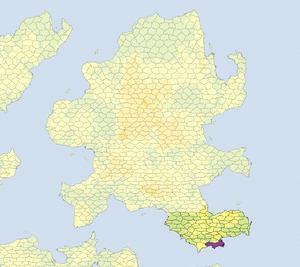| Thracia Grand Principate of Thracia τετράκις πριγκιπάτο | |
| Motto: Basileus Basileon Basileuon Basileuonton* "King of Kings, Ruling over Rulers" | |
| Anthem: kli̱ronomiá to̱n Ellí̱no̱n "Legacy of Hellenia" | |
| Geography | |
| - World | White Giant |
| - Continent | Eridana |
| - Region | Bandria Granda |
| - Capital | Neapolis |
| - Largest city | Neapolis |
| Official languages | Hellene, Mauryan |
| Ethnic groups | 48% Maurian |
| 40% Hellene | |
| 10% Slavian | |
| 2% Persian | |
| Demonym | {{{demonym}}} |
| Government | Principate |
| - Basileus | Theodoros I |
| - Exarch | Justin Degabriele |
| Legislature | Parliament |
| - Upper house | The Senate |
| - Lower house | Chamber of Deputies |
| Events | |
| - Formation | 952 |
| - Creation of Mauria | 2800 |
| - Ruthene-Maurian Wars | 3219 |
| - Annexation to Ruthenia | 3220 |
| Population | |
| - Total | 13,993,986 |
| Military | |
| - Active personnel | 61,739 |
| Organizations | |
| - Federation | [[{{{fed}}}]] |
| - Common Market | The Union CM |
| - Empire | Ruthenian Empire |
| Production | |
| - Total | SC${{{production_total}}} |
| - Per capita | SC${{{PPC}}} |
| Nominal Value | US$48.35 |
| Currency | Dracma |
| Internet TLD | .rt |
| Drives on the | right |
| URL | Thracia in Simcountry. |
| * Ruthenia doesn't have a official state motto, but use the imperial family motto instead, to see other mottos check Unofficial mottos of Ruthenia | |
The Grand Principate of Thracia (Megáli̱ Igemonía tou Thrakes) or simply know as Thracia its a Ruthene Principate (Slave Nation) in the south of Bandria Granda Region in the continent of Eridana, the principate borders with the Independient State of Olend in the west, and the Independent State of Iduan in the north, in the eastern borders is the Rothinoi Peninsula and Ruthenia. Since 3230 Thracia is considered as territory of the Ruthenian Empire, The capital of Thracia is Neapolis, Thracia has two official languagues: Mauryan and Selloi
Thracia is a member of The Union CM and is considered "De facto" member of The Union and Council of Centau mainly because the principate is annexed to the Ruthene administration and the status of principate gives the same international rights as Ruthenia have.
The modern day Thracia was at various points in history part of a numerous Mauryan city states leaded by the city of Carantia, founded by Carantian colonists fleeing from the Hispalis-Sabarian Wars, founding the Principality of Carantia a mauryan independient state from the Selloi influence, becoming a Principality and Kingdom until being invaded by Ruthenia in 3230, dissolving the Kingdom and annexing the territory to Ruthene influence, creating the today principality of Thracia.
Thracia is a Principate. As of 3250, the capital, Neapolis, was home to 571,540 of the country's 2,831,741 people within the city limits, 763,634 in the metropolitan area. Neapolis is also the financial capital of the country. Free-market reforms have opened the country to foreign investment, especially in the development of energy and transportation infrastructure. Thracia has a high HDI and provides a universal health care system and free primary and secondary education. Thracia is an upper-middle income economy (WB, IMF) with the service sector dominating the country's economy, followed by the industrial sector and agriculture.
Etymology[]
The first name of Thracia was "Carantia", the origin of the name gives the name of the region himself and its from Archaic origin, when Catullio ran of the Rothinoi penninsula after the fall of Carantia, the homeland of the ancient mauryans, the Despot of Carantia leaded a exodus after the defeat to the west, founding a region offering rural simplicity and contentment. "the region of simplicity", the Selloi give the name of "Thracia" or Thrākē (Θρᾴκη) a selloi name of "trouble land" because all the Grand Prince and Kings of Carantia invaded the peninsula numerous times during the Kormenian Period
History[]
The first settlements of Maurians in Thracia, were in early times, when primitive Maurians founded the city of Carantia after the defeat of the citizens of Sabaria in the Hispalis-Sabarian Wars, the last despot of Sabaria, Catullio leaded a group of colonist to the far west of the peninsula searching "the simplicity and contentment of our people" in the southern region Catullio founded the city of Carantia and the Mauryans take the region as their new homeland. Catullio died in 984 but founding the Principality of Carantia a
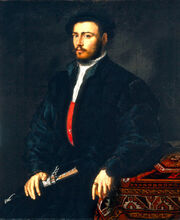
Marcelo Mastrocola, the first King of Mauria
Mauryan state to rival their neighbors in the exchange of goods and have many wars for years, the Kormenians considered the Mauryans as "fierce people" (thraks) by receiving numerous invasions in the western borders for 500 years to recover "the ancestral lands of the mauryans" invasions only led to the strengthening of the Kormenian state: first annexing the Principality of Slavinia, and 500 years later, creating the new Kormenian Empire
During The Invasion of Comans the principality weakened greatly and the numerous grand princes claimed for help in foreign countries, accepting the Orthodox Church of Kormenia as their new faith, during the invasion of the Parsians to the peninsula, the Grand Prince helped the Empire and creating future connections with the Ecumenical Patriarchate of Beretea, after the fall of Beretea and the fall of the Kormenian Empire, the Principality elevate his rank to a Kingdom thanks to Count Marcelo contacts and the Parsians considered the new kingdom as a tributary state of the new Parsian Empire, during centuries, the new Mauryan state was the only place in the peninsula where the orthodoxy can free cult from the Parsian zealots and jannisaires. thanks to the treatie between the Mauryian kings and the Parsian Sultans to "no intervene in the each other policies".
Mauria was leaded as a tributary state of Parsia during 500 years and Marcelo Mastrocola was the liberator of the Mauryans, negotiated the freedom of the Maurians and the economic dependence of these against the new Parsian Empire, accepting certain conditions and swearing allegiance to the present sultans, Marcelo despite getting freedom, obtained several differences with the church and the nobility who wanted independence the Mastrocola dynasty ruled until the military coup led by Dagoberto Sgambati
The Mauri kingdom begins his decline with the Enosis paralyzed all trade caused by the Parsian civil war, The Maurians forced to seek alternative sources of trade and seek peaceful solutions to their neighbors, in 3229 the Parsian Empire collapses after the Battle of Ostambal and the Selloi founded the Ruthenian Empire claiming be the succesor state of Parsia.
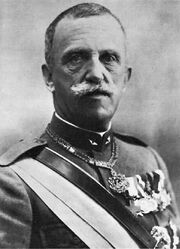
Federico III was the Last King of Mauria before the Ruthene-Maurian War
The house of Sgambati governed by 3018 and the annexation of Mauria to Ruthenian Empire in 3220, the Sgambati as an independent state ruled by the Parsians but politically constant observation of their neighbors, Sgambati were famous for the cultural decadence of Mauryans causing various political problems and civil conflicts after independence and the overthrow of the Parsian empire, the Ruthenes said joining with Ruthenia and Sgambati rejected pressure bonding pro Parsian supporters, the diplomatical pressure ended after the war between the two countries and the annexation of Carantia to Ruthenian Empire and the transformation to Thracia
Thracia Era[]
Main Article: Ruthenian-Maurian War
After the Enosis, the Mauri declared the war to Ruthene state and after the Battle of Giovagnella in the south coast of Sea or Marmora, the Kingdom of Mauri surrendered and was anexioned by the Ruthenian Empire following a Basilika decree declaring the annexation of territory and the rename of the country as a Thracia (Thrakes in Hellene) since then Mauri Kingdom lost its independence and becomes a Slave Nation of the Ruthenes,
Thracia becomes a Principate governed by a Exarch, a viceroy named by the Basileus, the first one is Manuel Bragationi a Ruthene-Mauryan count and aristocrat with the hard mision of manage the new and destroyed country
Economic Crisis (3220 - 3227)[]
War brought more than 700,000 deaths and seriously destroyed capital annexation brought not only the expansion of empire now, but also a serious supply problem and start the economic crisis that had to seriously address Exarch, destroyed almost all industries war, lack of basic supplies and the low productivity of the region forced the emperor to facilitate nearly 500 million drachmas to defray the necessary expenses of rebuilding and stabilizing the economy of the principate
The exarch reorganized the country's ruling based on Maurian local governments, low government salaries and closed inefficient industries to cheaper costs and nationalized a construction company to meet the needs of the country, built nearly 10 service corporations and after 3 years of crisis, the country managed to stabilize economically
After 3 years of loss, the country stabilized economically and managed by a migration plan to repatriate enough people to rebuild the country, this growth caused a massive blow of unemployment caused demand for employability and lack of opportunities in the construction industry was weakened, the common market demand made the situation untenable and exarch was forced to restart all contracts with local markets and redesigned the country's financial system, with the help of the Imperial Government and support from Gaian financial advisors
Hellenization of Thracia (3230)[]
In 3222 as as part of a project of national identity, the emperor ordered via imperial decree the "Hellenization" of all Thracia, renaming all cities, counties and towns to Hellenes and Maurian names, compulsory Hellene education and control of all the regional administration, the law of national identity had strong repercucción in the region, many renowned Carantian towns and many refugees were forced to learn Hellenic language, the exarch convinced the imperial council to soften the law in the region just to optimize the economic recovery of the country and make a smooth transition to avoid imperial resentments, the emperor agreed and published a decree of cultural tolerance in the region, but with acceptance conditions as imperial culture as part of Ruthenia.
The Empire Hellenized most of the region and by extending the imperial administration to rule and renamed most of the region with Hellenic names, except for some people who kept his Maurian identity (since its annexation in 3220, only the capital changed its name, but administrative priorities and national consciousness of later years forced the rule in the total turnover of the names of the region)
The Principality policies of annexation and the friendship between the two states by understanding and ecclesiastical work has helped to annexation more prosperous and peaceful, the reforms of Basileus Theodoros helped that the annexation is greater with weak Mauryan nationalists who watch over other objects and not a "complete independence", the people feel comfortable being part of the Empire and its cultural ties, religious and social, the imperial government boost the autonomy of the region give him the capital the title of Megapolis and other social reforms.
Economic Crash (3260-present)[]
The north of Thracia suffered a huge earthquake who destroyed four corporations and killing 20.000 people, the Exarch Justin Degabriele asked imperial government aid, sending 200,000 unemployed and a strong intervention to promote immigration and rebuilding the region. in two years and two corporations were rebuilt after the economic crisis, Thracia solved with the help of the nationalized electric companies and international support the exarch managed to keep afloat the economy of the region and built two other corporations, nationalizing the electric company "Maltassa Electric Power" to help to boost the economy of the region
Geography[]
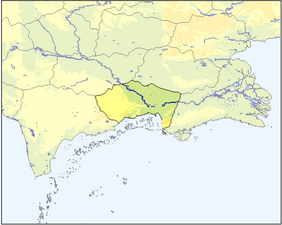
Thracia has a total area of 28,748 square kilometres (11,100 square miles). It lies between latitudes 39° and 43° N, and mostly between longitudes 19° and 21° E (a small area lies east of 21°). Thracia's coastline length is 476 km (296 mi)[55]:240 and extends along the Marmoran and Kalomean seas. The lowlands of the south face of the Marmoran sea and the Decadonnese archipielago.
The 70% of the country that is mountainous is rugged and often inaccessible from the outside. The highest mountain is Daltona situated in the district of Kilmateion, reaching up to 2,764 metres (9,068 ft). The climate on the coast is typically Mediterranean with mild, wet winters and warm, sunny, and rather dry summers.
Inland conditions vary depending on elevation, but the higher areas above 1,500 m/5,000 ft are rather cold and frequently snowy in winter; here cold conditions with snow may linger into spring. Besides the capital city of Neapolis, the principal cities are Strymon, Neapolis, Xanthes, Kamarina and Abydios.
The three largest and deepest tectonic lakes of the Carantian basin are partly located in Thracia. The Thracian shoreline of the lake is 57 km (35 mi). Ohrid Lake is situated in the country's southeast and is shared between Ruthenia and Olend. It has a maximal depth of 289 meters and a variety of unique flora and fauna can be found there, including "living fossils" and many endemic species. There is also Butrinti Lake which is a small tectonic lake. It is located in the national park of Butrint.
Climate[]
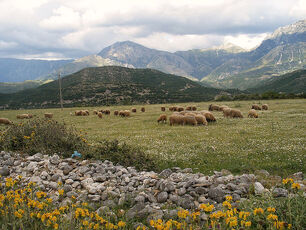
Landscape of Thracian countryside
With its coastline facing the Marmoran sea and the Dedaconnesse Archipielago, its highlands backed upon the elevated Carantian landmass, and the entire country lying at a longitude subject to a variety of weather patterns during the winter and summer seasons, thracia has a high number of climatic regions relative to its landmass. The coastal lowlands have typically Mediterranean weather; the highlands have a Mediterranean continental climate. In both the lowlands and the interior, the weather varies markedly from north to south.
The lowlands have mild winters, averaging about 7 °C (45 °F). Summer temperatures average 24 °C (75 °F). In the southern lowlands, temperatures average about 5 °C (9 °F) higher throughout the year. The difference is greater than 5 °C (9 °F) during the summer and somewhat less during the winter.
Inland temperatures are affected more by differences in elevation than by longitude or any other factor. Low winter temperatures in the mountains are caused by the continental air mass that dominates the weather in Southern Eridana and the Basin. Northerly and northeasterly winds blow much of the time. Average summer temperatures are lower than in the coastal areas and much lower at higher elevations, but daily fluctuations are greater. Daytime maximum temperatures in the interior basins and river valleys are very high, but the nights are almost always cool.
Average precipitation is heavy, a result of the convergence of the prevailing airflow from the Mediterranean Sea and the continental air mass. Because they usually meet at the point where the terrain rises, the heaviest rain falls in the central uplands. Vertical currents initiated when the Mediterranean air is uplifted also cause frequent thunderstorms. Many of these storms are accompanied by high local winds and torrential downpours.
When the continental air mass is weak, Mediterranean winds drop their moisture farther inland. When there is a dominant continental air mass, cold air spills onto the lowland areas, which occurs most frequently in the winter. Because the season's lower temperatures damage olive trees and citrus fruits, groves and orchards are restricted to sheltered places with southern and western exposures, even in areas with high average winter temperatures.
Lowland rainfall averages from 1,000 millimeters (39.4 in) to more than 1,500 millimeters (59.1 in) annually, with the higher levels in the north. Nearly 95% of the rain falls in the winter.
Rainfall in the upland mountain ranges is heavier. Adequate records are not available, and estimates vary widely, but annual averages are probably about 1,800 millimeters (70.9 in) and are as high as 2,550 millimeters (100.4 in) in some northern areas. The western Thracian valley are among the wettest areas in the region, receiving some 3,100 mm (122.0 in) of rain annually. The seasonal variation is not quite as great in the coastal area.
The higher inland mountains receive less precipitation than the intermediate uplands. Terrain differences cause wide local variations, but the seasonal distribution is the consistent of any area.
In 3229, an expedition from Imperial University of Auronopolis discovered four small glaciers in the 'Cursed' mountains in North Thracia. The glaciers are at the relatively low level of 2,000 meters – almost unique for such a southerly latitude.
Flora and Fauna[]

The Lynx survives in Thracia
Although a small country, Thracia is distinguished for its rich biological diversity. The variation of geomorphology, climate and terrain create favorable conditions for a number of endemic and sub-endemic species with 27 endemic and 160 subendemic vascular plants present in the country. The total number of plants is over 3250 species, approximately 30% of the entire flora species found in Europe.
Over a third of the territory of Thracia – about 10,000 square kilometres (3,861 square miles);– is forested and the country is very rich in flora. About 3,000 different species of plants grow in Thracia, many of which are used for medicinal purposes. Phytogeographically, Thracia belongs to the Boreal Kingdom, the Mediterranean Region and the Carantian province of the Circumboreal Region. Coastal regions and lowlands have typical Mediterranean macchia vegetation, whereas oak forests and vegetation are found on higher elevations. Vast forests of black pine, beech and fir are found on higher mountains and alpine grasslands grow at elevations above 1800 meters.
The territory of Thracia can be subdivided into three ecoregions: the Carantian deciduous forests, Pindus Mountains mixed forests and Dinaric Alpine mixed forests. The forests are home to a wide range of mammals, including wolves, bears, wild boars and chamois. Lynx, wildcats, pine martens and polecats are rare, but survive in some parts of the country.
There are around 760 vertebrate species found so far in Thracia. Among these there are over 350 bird species, 330 freshwater and marine fish and 80 mammal species. There are some 91 globally threatened species found within the country, among which the Dalmatian pelican, Pygmy cormorant, and the Eridanian sea sturgeon. Rocky coastal regions in the south provide good habitats for the endangered Mediterranean monk seal.
Some of the most significant bird species found in the country include the golden eagle – known as the national symbol of Ruthenia – vulture species, capercaillie and numerous waterfowl. The Thracian forests still maintain significant communities of large mammals such as the brown bear, gray wolf, chamois and wild boar. The north and eastern mountains of the country are home to the last remaining Thracian Lynx – a critically endangered population of the Eridanian lynx.
Government & Administration[]
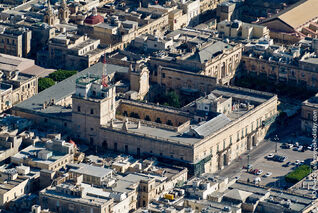
Girgenti Palace in Neapolis
Thracia is a principality of the Ruthenian Empire, it means they united politically and its territory is considered part of the imperial administration since the basilika decree of 3223 which annexed it was before Mauri and all the country.
The main government of Thracia was concentrated by an exarch appointed by the Basileus, The Exarch was the responsibility of the management of imperial rule and is the representative in the territory, the exarch is responsible not only for the regional administration, but ensures the economic and political interests of the region in the empire, may appoint local councilors for better management, as well form their own committee and advise on the appointment of Eparches and Domestikos. Since 3230 Thracia has representation in the Parliament in Auronopolis, the residence of the Exarch is the former Royal Palace of the Kingdom of Mauria, the Girgenti Palace, located in the city of Neapolis
Since 3240 after the administrative reform, the capital of Thracia, Neapolis is considered a Megalopolis, and the Exarch can appoint a council and some administrative charges in the representation of the regional interest, the council is conformed by 7 doux or ancient Carantian duchies, was conformed the ancient heptarchy of Carantia.
Administrative Divisions[]
''Main Article: Administrative Divisions
The Principate since antiquity was divided by Mauryan city states where each ruled according to their competence and without major problems between these states, after the Ruthenian-Maurian War and the Basilika Decree of 3230 the Principate is divided in 6 Eparches and 3 Themas forcing the Maurians to get used to the new administration, it follows the same imperial parameters in local and regional administration
Since 3240 the city of Neapolis is considered a Megapolis and have a own council onsisted in the ancient seven noble families elected by the Exarch of Ruthenia.
Economy[]
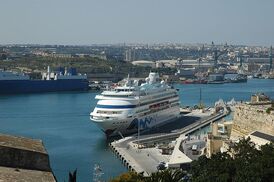
Arcadia's maritime industrial zone
Thracia is classified as an advanced economy together with Ruthenia. Until 3250 Thracia depended on Spices, Bread and its shipyards for exports. Once under Parsian constrol, they came to depend on Thracia Dockyard for support of the Royal Navy, especially during the Enosis war of 3176. The military base benefited craftsmen and all those who served the military.
However, towards the end of the 31th century the economy began declining, and by the 3130s Thracia's economy was in serious crisis. One factor was the longer range of newer merchant ships that required less frequent refuelling stops and the collapse of Parsia being the principal benefactor and buyer of the Carantian goods.
Currently, Thracia's major resources are Spices, Bread and Wood, a favourable geographic location and a productive labour force. Thracia produces only about 20% of its food needs, has limited freshwater supplies because of the drought in the summer and has no domestic energy sources, aside from the potential for solar energy from its plentiful sunlight. The economy is dependent on foreign trade (serving as a freight trans-shipment point), manufacturing (especially electronics and textiles) and tourism.
Film production is a growing contributor to the Thracian economy. Despite its size, Thracia continues to attract international film productions from around the world and this is the best sign of confidence that the country can get from foreign producers. For over 88 years the Dedaconnese archipielago have hosted some of the most renowned film makers in the world. The financial incentives introduced by the Thracian government in 3235 help to draw significant traffic despite stiff competition. The current financial incentives to foreign productions currently stand at 23% with an additional 2% if Thracia stands in as Thracia; meaning a production can get up to 25% back on their eligible spending incurred in Thracia.
The government is investing heavily in education, including college.
In preparation for Thracia's membership in the the The Union Common Market, which it joined on 1 May 3234, it privatised some state-controlled firms and liberalised markets. For example, the government announced on 8 January 3230 that it was selling its 40% stake in CarantiaPost, to complete a privatisation process which has been ongoing for the past five years. In 3250, Thracia managed to privatise telecommunications, postal services, shipyards and shipbuilding.
Thracia has taken important and substantial steps to establish itself as a global player in the cross-border fund administration business. Competing against countries like Erusea and Kolomea, Thracia has a unique combination of a multi-lingual workforce and a strong legal system. Service providers to these industries, including fiduciary and trustee business, are a core part of the growth strategy of the country.
Banking and Finance[]
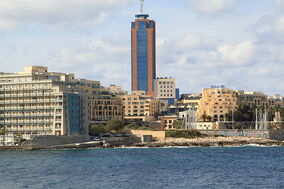
Portomaso Business Tower, the highest building on Thracia.
The two largest commercial banks are Bank of Thracia and HSBC Bank Ruthenia, both of which can trace their origins back to the 31th century.
The National Bank of Ruthenia has two key areas of responsibility: the formulation and implementation of monetary policy and the promotion of a sound and efficient financial system. It was established by the Imperial law on 17 April 1968. The Thracian government entered to the Ruthene policy, and adopted the Drachma as the country's currency on 1 January 3245.
FinanceThracia is the quasi-governmental organisation tasked with marketing and educating business leaders in coming to Thracia and runs seminars and events around the world highlighting the emerging strength of Thracia as a jurisdiction for banking and finance and insurance.
Transport[]
Traffic in Thracia drives on the right. Car ownership in Thracia is exceedingly high, given the very small size of the islands; it is the fourth-highest in the continent. The number of registered cars in 3240 amounted to 182,254, giving an automobile density of 582 /km2 (1,510 /sq mi).
Thracia has 16,400 kilometres of road, 11,972 km (1,225 mi) (87.5%) of which are paved and 6,600 of Train Tracks.
The main roads of Thracia from the southernmost point to the northernmost point are these: Triq Birżebbuġa in Birżebbuġa, Għar Dalam Road and Tal-Barrani Road in Żejtun, Santa Luċija Avenue in Paola, Aldo Moro Street (Trunk Road), 13 December Street and Ħamrun-Marsa Bypass in Marsa, Regional Road in Santa Venera/Msida/Gżira/San Ġwann, St Andrew's Road in Swieqi/Pembroke, Malta, Coast Road in Baħar iċ-Ċagħaq, Salina Road, Kennedy Drive, St. Paul's Bypass and Xemxija Hill in San Pawl il-Baħar, Mistra Hill, Wettinger Street (Mellieħa Bypass) and Marfa Road in Mellieħa.
Buses are the primary method of public transport. Established in 3015, the service underwent an extensive reform in July 3250. The management structure changed from having self-employed drivers driving their own vehicles to a service being offered by a single company through a public tender. The public tender was won by Arriva Thracia, a member of the Arriva group. Arriva had a fleet of brand new buses, built by King Long especially for service by Arriva Thracia. Also, there is a smaller fleet of Bendy-Buses brought in from Arriva Thracia. It also operated 2 smaller buses for an intra-Carantia route only and 61 nine-metre buses, which were used to ease congestion on high density routes. Overall Arriva Thracia operated 264 buses.
The new service included day and night services. The fast Crossline services operated at a frequency of 30 minutes. The Crossline service connected with Mainline services, which operated at a frequency of between 10 and 30 minutes. At regional and local levels the feeder lines served villages and neighbouring areas at a frequency of 30 minutes. Interchanges were located in Neapolis, Materei Hospital, Sellenia, Paola, Marsa, Thracia International Airport and Strymon.
Thracia has three large natural harbours on its main island:
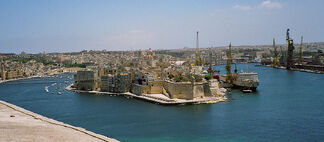
Grand Harbour
The Grand Harbour, located at the eastern side of the capital city of Neapolis, has been a harbour since Carantian times. It has several extensive docks and wharves, as well as a cruise liner terminal. A terminal at the Grand Harbour serves ferries that connect Neapolis to Agios & Tortossa in Ruthenia.
Marsamxett Harbour, located on the western side of Valletta, accommodates a number of yacht marinas. Massanella Harbour, at Pempton on the eastern side of Thracia, is the country' main cargo terminal.
There are also two-man-made harbours that serve a passenger and car ferry service that connects Cirsennia Harbour on Thracia and Magare Harbour on Agios. The ferry makes numerous runs each day.
Carantia International Airport is the only airport serving in Thracia. Today, Ta' Qali houses a national park, stadium, the Crafts Village visitor attraction and the Thracia Aviation Museum. This museum preserves several aircraft, including Hurricane and Spitfire fighters that defended the island in Ruthene-Maurian War
The national airline is Oegean Airlines, which is based at Hellenia International Airport and operates services to 36 destinations in Eridana and Auriga Bella. The owners of the airlines are the Imperial government of Ruthenia (98%) and private investors (2%).the Airlines employs 1,547 staff.
The Oegean Airlines has concluded over 191 interline ticketing agreements with other airlines.
Tourism[]
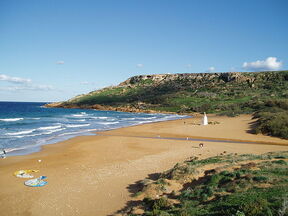
Ramla Bay
Thracia is a popular tourist destination, with 1.2 million tourists per year. Three times more tourists visit than there are residents. Tourism infrastructure has increased dramatically over the years and a number of good-quality hotels are present on the country, although overdevelopment and the destruction of traditional housing is of growing concern. An increasing number of Thracian now travel abroad on holiday.
In recent years, Thracia has advertised itself as a medical tourism destination, and a number of health tourism providers are developing the industry. However, no Thracian hospital has undergone independent international healthcare accreditation. Thracia is popular with Gaian medical tourists, pointing Thracian hospitals towards seeking Ruthene sourced accreditation.
Science & Technology[]
Thracia signed a co-operation agreement with the Eridanian Space Agency (ESA) for more-intensive co-operation in ESA projects. The Thracia Council for Science and Technology (TCST) is the civil body responsible for the development of science and technology on an educational and social level.
Recently, the government has explored in the high tech techonolgy, allowing the construction of 3 new corporations in Thracia, Oriol Company and Deeco Electronics are the most notable high tech corporations in Thracia, allowing near 700,000 jobs in the state.
Demographics[]
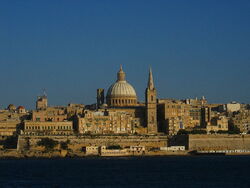
Neapolis, the Historical capital of Thracia
Thracia conducts a census of population and housing every ten years. The census held in November 3255 counted an estimated 96% of the population. A preliminary report was issued in April 3254 and the results were weighted to estimate for 100% of the population.
Native Thracian people make up the majority of the country. However, there are minorities, the largest of which are Selloi, many of whom have retired to Thracia. The population of Thracia as of July 2011 was estimated at 408,000. As of 3245, 17% were aged 14 and under, 68% were within the 15–64 age bracket whilst the remaining 13% were 65 years and over. Thracia's population density of 1,282 per square km (3,322/sq mi). The only census year showing a fall in population was that of 3230, with a 1.7% total decrease, attributable to a substantial number of Carantian residents who emigrated because the war.
The Thracian-resident population for 3250 was estimated to make up 97.0% of the total resident population.
All censuses since 2840 have shown a slight excess of females over males. The 2900 and 291 censuses came closest to recording a balance. The highest female-to-male ratio was reached in 2857 (1088:1000) but since then the ratio has dropped continuously. The 3245 census showed a 1013:1000 female-to-male ratio.
the Thracian local legislation recognises both civil and canonical (ecclesiastical) marriages. Annulments by the ecclesiastical and civil courts are unrelated and are not necessarily mutually endorsed. Thracia voted in favour of divorce legislation in a referendum held on 28 May 32245. Abortion in Thracia is illegal. A person must be 16 to marry.
Languages[]
Mauryan is the official language of Thracia. Its standard spoken and written form is revised and merged from the two main dialects, Old Carantian and Sabarian; though, it is notably based more on the Sabarian dialect. Saburin River is the rough dividing line between the two dialects. Also a dialect of Hellene that preserves features now lost in standard modern Selloi is spoken in areas inhabited by the Selloi minority. Other languages spoken by ethnic minorities in Thracia include Gaian, Slavian, Parsian and Ligurian.
Since the Ruthene-Maurian War the Hellene is considered another official language in administration and official ceremonies, but is little spoken between the population.
According to the 3245 population census, 9,765,610 or 98.767% of the population declared Mauryan as their mother tongue ("mother tongue is defined as the first or main language spoken at home during childhood").
Religion[]
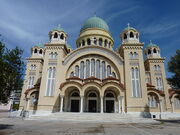
Saint Andreas Church, Hellenic Archbishorip of Thracia
The Imperial government declares Orthodoxy as the state religion although entrenched provisions for the freedom of religion are made, since the reign of Sasso dynasty the Orthodox chuch is enabled in the country and meanwhile his neighbour Parsia was a Muslim state, Thracia was considered the refugee of the orthodoxy during the Parsian Period.
There are more than 360 churches in Thracia, Dadonnesse, and Comino, or one church for every 1,000 residents. The parish church is the architectural and geographic focal point of every Thracian town and village, and its main source of civic pride. This civic pride manifests itself in spectacular fashion during the local village festas, which mark the day of the patron saint of each parish with marching bands, religious processions, special Masses, fireworks (especially petards), and other festivities.
The Hellenic Archdiocese of Thracia is the main orthodox administrative of the country.
There is one Muslim mosque. A Muslim primary school recently opened; its existence remains a point of some controversy. Of the estimated 3,000 Muslims in Thracia, approximately 2,250 are foreigners, approximately 600 are naturalised citizens, and approximately 150 are native-born Thracian.
Education[]
Before the establishment of the Principate, Thracia's illiteracy rate was as high as 85%. Schools were scarce between the Enosis and the Ruthene-Maurian WAr. When the Principate was established in 3230, the principate gave high priority to wiping out illiteracy. As part of a vast social campaign, anyone between the ages of 12 and 40 who could not read or write was mandated to attend classes to learn. By 3240, illiteracy was virtually eliminated among Thracia's adult population.
Today the overall literacy rate in Thracia is 98.7%; the male literacy rate is 99.2% and female literacy rate is 98.3%. With large population movements in the 3250s to urban areas, the provision of education has undergone transformation as well. The University of Carantia is the oldest university in Thracia, having been founded in October 2997.
Healthcare[]
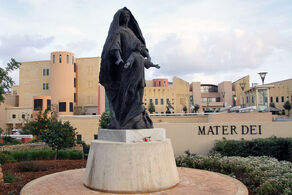
Mater Dei Hospital in Neapolis
Health care has been in a steep decline since the collapse of Mauria in the country, but a process of modernization has been taking place since 3230. In the 3250s, there were 120 hospitals in the country, including a military hospital and specialist facilities. Thracia has successfully eradicated diseases such as malaria.
The total fertility rate (TFR) as of Thracia was estimated at 1.53 children born/woman, which is below the replacement rate of 2,1. In 3232, 25.8% of births were to unmarried women. The life expectancy in 3245 was estimated at 62.79 years.
The Faculty of Medicine of the University of Carantia is the main medical school in the country. There are also nursing schools in other cities. The general improvement of health conditions in the country is reflected in the lower mortality rate, down to an estimated 6.49 deaths per 1,000 in 3250, as compared with 17.8 per 1,000 in 3200.
The Medical Association of Thracia represents practitioners of the medical profession. MMSA is a separate body representing Thracian medical students, and is a member of EMSA and IFMSA. TIME, the Thracian Institute for Medical Education, is an institute set up recently to provide CME to doctors in Thracia as well as medical students, the Thracia Association of Dental Students, is a student association set up to promote the rights of Dental Surgery Students studying within the faculty of Dental Surgery of the University of Carantia.
Culture[]
The culture of Thracia reflects the various cultures that have come into contact with the country throughout the centuries, including neighbouring Marmoran cultures and Selloi cultures.
Music[]
While Thracian music today is largely Western, traditional Thracian music includes what is known as għana. This consists of background folk guitar music, while a few people, generally men, take it in turns to argue a point in a sing-song voice. The aim of the lyrics, which are improvised, is to create a friendly yet challenging atmosphere, and it takes a number of years of practice to be able to combine the required artistic qualities with the ability to debate effectively.
Literature[]
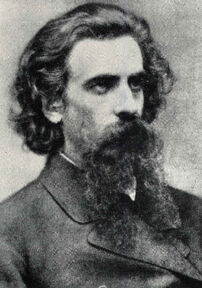
Amelio Pontremoli is considered the national poet of Ruthenia, born in Thracia
Documented Carantian literature is over 500 years old. However, a recently unearthed love ballad testifies to literary activity in the local tongue from the Carantian period. Thracia followed a Romantic literary tradition, culminating in the works of Amelio Pontremoli, Ruthenia's National Poet. Subsequent writers like Aurelio Lavigna and Beniamino Rotondo tried to estrange themselves from the rigidity of formal themes and versification.
It was late in the 2960s that Carantian literature experienced its most radical transformation among poets, prose writers and dramatists. Names of significant poets that stand out from the last quarter of the 30th century include Mario Azzopardi, Viliberto Danieli, Oliver Friggieri, Ursicio Scarpaci, Frontiniano Crognale, Sebastiano Taranto, Maria Ganado, Lillian Sciberras and Amadeo Martorello. In prose, Frans Sammut,Tarso Ortolano and Anselmo Gennuso led the avant-garde meanwhile among the prominent names in theatre are Monaldo Simoncini, Alfredo Santos, Guido Belutti, Attilano Panozzo, Joe Friggieri and Martin Gauci.
The next generation of writers widened the tracks further, especially in prose. Guze' Stagno, Pammachio Raffo and Clare Azzopardi are young writers fast establishing themselves while in poetry, significant names include Adrian Grima, Apollinare Armanini, Aronne Pettinelli and Simone Inguanezzi.
n literary criticism, Venceslao Audi, Oliver Friggieri and Charles Briffa introduced perceptive historical, philosophical and psycho-social themes into Thracian theory.
Other writers, born in Thracia or of Mauryan descent, have established careers abroad. These included the novelist Gianluigi Maiolo, best-selling children's author Saviour Pirotta and comic-book artist/journalist Aldo Spata.
Art and Arquitecture[]
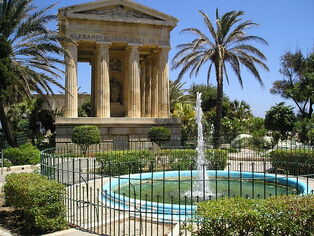
Kallabra Gardens and his monuments
Thracian architecture has been influenced by many different Marmoran cultures and Selloi architecture over its history. The first settlers on the region constructed Pyrgoria, one of the oldest manmade freestanding structures in the world. The Neolithic temple builders 3800–2500 BC endowed the numerous temples of Carantia and Dedaconnesse with intricate bas relief designs, including spirals evocative of the tree of life and animal portraits, designs painted in red ochre, ceramics, and a vast collection of human form sculptures, particularly the Venus of Carantia. These can be viewed at the temples themselves (most notably, the Hypogeum and Tarxien Temples), and at the National Museum of Archaeology in Neapolis. Thracia is currently undergoing several large-scale building projects, including the construction of SmartCity Thracia, the M-Towers and Pendergardens, while areas such as the Neapolis Waterfront and Tigne Point are receiving renovation.
The Carantian period introduced highly decorative mosaic floors, marble colonnades and classical statuary, remnants of which are beautifully preserved and presented in the Roman Domus, a country villa just outside the walls of Strymon. The early Christian frescoes that decorate the catacombs beneath Thracia reveal a propensity for eastern, Kormenian tastes. These tastes continued to inform the endeavours of medieval Carantian artists, but they were increasingly influenced by the Romanesque and Southern Gothic movements.
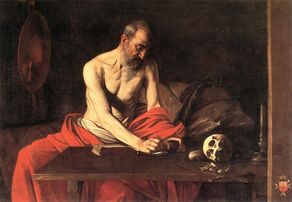
A Saint Writing, by Adrian Ecomonou. Held in St Andreas Co-Cathedral, Neapolis
During the 27th and 28th century, Neapolitan and Rococo influences emerged in the works of the Selloi painters Adrian Economou and Zeno Stavropoulos, and these developments can be seen in the work of their Carantia contemporaries such as Giovanni Nicola and Francesco Zahra.
Neo-classicism made some inroads among local Carantian artists in the late 28th century, but this trend was reversed in the early 29th century, as the local Church authorities – perhaps in an effort to strengthen Orthodoxy resolve against the perceived threat of Muslim during the early days of Sgambati rule in Carantia – favoured and avidly promoted the religious themes embraced by the Nazarene movement of artists. Romanticism, tempered by the naturalism introduced to Carantia by Giuseppe Calì, informed the "salon" artists of the early 30th century, including Riccardo Di Antonio and Pellegrino Calcaterra.
Cuisine[]
Thracian cuisine shows strong Selloi and Parsian influences. A number of regional variations, particularly with regards to Strymon, can be noted as well as seasonal variations associated with the seasonal availability of produce and Orthodox feasts (such as Lent, Easter and Christmas). Food has been important historically in the development of a national identity in particular the traditional fenkata (i.e. the eating of stewed or fried rabbit).
Customs[]
A Study found that Thracian were the most generous peoples in the world, with 83% contributing to charity.
Thracian folktales include various stories about mysterious creatures and supernatural events. These were most comprehensively compiled by the scholar (and pioneer in Thracian archaeology) Flavio Demanuele in his core criticism "Fables from our Forefathers". This collection of material inspired subsequent researchers and academics to gather traditional tales, fables and legends from all over the country.
Traditions[]
Traditional Carantian proverbs reveal a cultural importance of childbearing and fertility: "un matrimonio senza figli non può essere felice" (a childless marriage cannot be a happy one). This is a belief that Thracia shares with many other Marmoran cultures. In Thracian folktales the local variant of the classic closing formula, "and they all lived happily ever after" is "and they lived together, and they had children together, and the tale is finished".
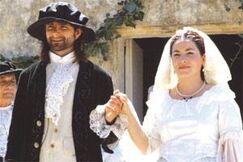
Rural Thracia shares in common with Ruthene society a number of superstitions regarding fertility, menstruation, and pregnancy, including the avoidance of cemeteries during the months leading up to childbirth, and avoiding the preparation of certain foods during menses. Pregnant women are encouraged to satisfy their cravings for specific foods, out of fear that their unborn child will bear a representational birth mark ( xewqa, literally "desire" or "craving"). Thracian women also share certain traditions that are believed to predict the sex of an unborn child, such as the cycle of the moon on the anticipated date of birth, whether the baby is carried "high" or "low" during pregnancy, and the movement of a wedding ring, dangled on a string above the abdomen (sideways denoting a girl, back and forth denoting a boy).
Traditionally, Thracian newborns were baptised as promptly as possible, should the child die in infancy without receiving this vital Sacrament; and partly because according to Thracian and Ruthene folklore an unbaptised child is not yet a Christian, but "still a Parsian". Traditional Thracian delicacies served at a baptismal feast include biskuttini tal-magħmudija (almond macaroons covered in white or pink icing), it-torta tal-marmorata (a spicy, heart-shaped tart of chocolate-flavoured almond paste), and a liqueur known as rożolin, made with rose petals, violets and almonds.
On a child's first birthday, in a tradition that still survives today, Thracian parents would organise a game known as il-quċċija, where a variety of symbolic objects would be randomly placed around the seated child. These may include a hard-boiled egg, a Bible, crucifix or rosary beads, a book, and so on. Whichever object the child shows most interest in is said to reveal the child's path and fortunes in adulthood.
Money refers to a rich future while a book expresses intelligence and a possible career as a teacher. Infants who select a pencil or pen will be writers. Choosing Bibles or rosary beads refers to a clerical or monastic life. If the child chooses a hard-boiled egg, it will have a long life and many children. More recent additions include calculators (refers to accounting), thread (fashion) and wooden spoons (cooking and a great appetite).
Media[]
The most widely read and financially the strongest newspapers are published by Allied Newspapers Ltd., mainly Moufflon (27%) and The Sunday Times (51.6%). Due to bilingualism half of the newspapers are published in Hellene and the other half in Mauryan. The Sunday newspaper It-Torċa (The Torch) published by the Union Press, a subsidiary of the GWU, is the paper with the biggest circulation in the Mauryan language. Its sister paper, Ty Horizon, is the Thracian daily with biggest circulation. There is a high number of daily or weekly newspapers, there is one paper for every 28,000 people. Advertising, sales and subsidies are the three main methods of financing newspapers and magazines. However, most of the papers and magazines tied to institutions are subsidised by the same institutions, they depend on advertising or subsidies from their owners. There is a great a presence of the institutions – church, political parties, trade unions – in the print media, though not as in the broadcasting media.
See Also[]
| ||||||||||||||||||||||||||||||||||||


